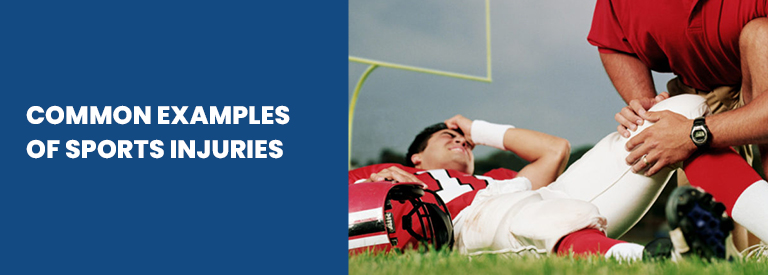It’s no secret that physical activity like sports and exercise are good for you. In addition to improving cardiovascular health, it can help manage weight, increase aerobic fitness, and increase muscular strength and endurance.
While some benefits can be gained from exercise, sometimes, when people overdo it or don’t properly warm up and train, they can also be harmed. These injuries are known as sports injuries.
Sports injuries are almost inevitable. Nevertheless, the possibility of injury should not deter you from participating in sports, but educating yourself about some of the most common sports injuries will enable you to prevent them or at least reduce your risk of getting injured.
In the end, how long it takes to recover from an injury depends on how well it is managed and rehabilitated. Here are some important things to know about if you’ve sustained a sports injury.
What Are Considered Sports Injuries?
Sports injuries are injuries that occur when engaging in sports or exercise. They can occur due to overtraining, lack of conditioning, and improper form or technique. Failing to warm up increases the risk of sports injuries. As we know it, the most common types of sports injuries include:
- Muscle strains and sprained joints
- Abrasions and cut wounds
- Broken bones
- Head trauma or concussion
Generally, there are two kinds of sports injuries. These are acute traumatic injuries and overuse injuries. Let’s differentiate the two:
Acute traumatic injuries
Things like fractures, sprains and strains, concussions, and cuts are examples of acute traumatic injuries. They usually happen after a blow or force — like getting tackled in football or wiping out while skateboarding. Common Acute Injuries include:
- Ankle Sprain
- Quadriceps Strain
- Clavicular Fracture
- Shoulder Dislocation
Specifically, an injury occurs suddenly to previously normal tissue. Acute injuries occur due to sudden trauma to the tissue, with the symptoms of acute injuries presenting themselves almost immediately. The principle in this instance is that the force exerted at the time of injury on the tissue (i.e. muscle, tendon, ligament, and bone) exceeds the strength of that tissue. Forces commonly involved in acute injury are either direct or indirect.
Overuse injuries
Overuse injuries occur over a period of time, usually due to excessive and repetitive loading of the tissue, with symptoms presenting gradually. Little or no pain might be experienced in the early stages of these injuries and the athlete might continue to place pressure on the injured site.
This prevents the site from being given the necessary time to heal. In contrast to acute injuries, the cause of overuse injuries is often much less obvious. The principle in overuse injury is that repetitive microtrauma overloads the capacity of the tissue to repair itself.
These injuries are also called chronic injuries because they happen over time, usually from repetitive training, like running, overhand throwing, or serving a ball in tennis. Overuse injuries might not seem serious at first. But if they’re not treated, they usually get worse.
Common Examples of Sports Injuries
 Common sports injuries are usually mild or moderate — the damage is there, but the person is still functional. You can treat them at home but you should expect that some common sports injuries may take months to heal, even with good treatment. Here are some specific tips for treating each of the most common sports injuries:
Common sports injuries are usually mild or moderate — the damage is there, but the person is still functional. You can treat them at home but you should expect that some common sports injuries may take months to heal, even with good treatment. Here are some specific tips for treating each of the most common sports injuries:
Ankle sprain
Most athletes have experienced a sprained ankle, which typically occurs when the foot turns inward. This turning stretches or tears the ligaments on the outside of the ankle, which are relatively weak.
Groin pull
This injury results from putting too much stress on muscles in your groin and thigh. If these muscles are tensed too forcefully or too suddenly, they can get over-stretched or torn. Groin pulls are common in people who play sports that require a lot of running and jumping.
Hamstring strain
Three muscles in the back of the thigh form the hamstring. The hamstring can be over-stretched by movements such as hurdling — kicking the leg out sharply when running. Falling forward while water skiing is another common cause of hamstring strains.
Shin splints
Pains down the front of the lower legs are commonly called “shin splints.” They are most often brought on by running — especially when starting a more strenuous training program like long runs on paved roads.
Knee injury: ACL tear
The anterior cruciate ligament (ACL) holds the leg bone to the knee. Sudden “cuts” or stops or getting hit from the side can strain or tear the ACL.
Knee injury: Patellofemoral syndrome
Patellofemoral syndrome can result from the repetitive movement of your kneecap (patella) against your thigh bone (femur), which can damage the tissue under the kneecap. Running, volleyball, and basketball commonly set it off. One knee or both can be affected.
Tennis elbow (epicondylitis)
Repetitive use of the elbow — for example, during golf or tennis swings — can irritate or make tiny tears in the elbow’s tendons. Epicondylitis is most common in 30- to 60-year-olds and usually involves the outside of the elbow.
Steps On How To Recover from A Sports Injury
Some common sports injuries may take months to heal, even with good treatment. However, there are still helpful ways to fully recover from these injuries. There are also steps that you should complete in rehabilitation and treatment of the injury before returning to sports or exercise. These include the following steps:
Allow healing
If you are bruised and sore, and perhaps on crutches or in a cast or splint, you probably will not be tempted to begin exercising the part of his body that is still hurting. Make sure that you check with your doctor first to make sure it is an activity, like swimming, that doesn’t put stress on the injured area.
Restore full range of motion and function in the injured area.
You should be doing the exercises your doctor or physical therapist has prescribed to restore range of motion. Using ankles as an example, if you can move the injured ankle in the same way and as far as his good ankle is concerned, you are ready to move on to the next step in the recovery process.
Regain normal gait
After a leg injury, many athletes find that they have lost their usual gait (the way they normally walk). When you are walking and jogging normally, you are ready for the next step in coming back from your injury. You are not allowed to return to sports if you are still limping.
Regain muscle strength
After an injury that has kept you from exercising for any length of time, you need to build back the strength in muscles that have been resting. Your doctor or trainer should give you weight-training exercises to build up the weakened muscles.
Regain endurance
Fortunately, most healthy athletes, especially kids, regain their endurance pretty quickly, but you won’t be really ready to play again until you do. It’s important that, in building endurance, you don’t stress your system.
Regain confidence
When you suffer an injury that keeps you out of sports for an extended period of time, you may suffer a psychological loss as well as physical injury. It is therefore important for you to not only be physically ready to return to sports but psychologically ready as well.
If you or your child has suffered due to a sports injury or accident, Diamond and Diamond’s personal injury lawyers can help. Contact us at 1-800-567-HURT to schedule a free consultation.
Contact A Sports Injury Lawyer In Ontario
Sports injuries can be life-changing events that can affect your everyday life. For this reason, it is critical for people who have sustained a head injury in a sports accident to speak with a lawyer about your legal options.
Diamond and Diamond’s sports injury lawyers are committed to protecting the legal rights of injured victims and strive to obtain the largest possible settlement or award in each case they take. To schedule a free consultation with one of our lawyers, please call our office today at 1-800-567-HURT!

Pro Tip
Physical activity is an important part of maintaining overall health. However, certain precautions, such as using the correct equipment and maintaining equipment, should be taken to minimize the risk of sports injuries.














